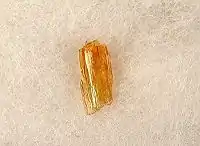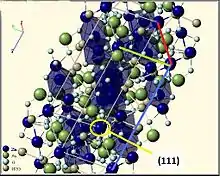| Warikahnite | |
|---|---|
 Warikahnite, Tsumeb mine, Namibia, 0.6 x 0.4 x 0.1 cm | |
| General | |
| Category | Arsenate minerals |
| Formula (repeating unit) | Zn3(AsO4)2•2H2O |
| IMA symbol | War[1] |
| Strunz classification | 8.CA.35 |
| Crystal system | Triclinic |
| Crystal class | Pinacoidal (1) (same H-M symbol) |
| Space group | P1 |
| Unit cell | a = 6.71 Å, b = 8.98 Å c = 14.53 Å; α = 105.59° β = 93.44°, γ = 108.68°; Z = 4 |
| Identification | |
| Formula mass | 510.04 g/mol |
| Color | Pale yellow to colorless; honey-yellow; orange |
| Crystal habit | Acicular; radial |
| Cleavage | [001] perfect, [010] good, [100] good |
| Fracture | Brittle |
| Mohs scale hardness | 2 |
| Luster | Vitreous, waxy |
| Streak | White |
| Diaphaneity | Transparent |
| Specific gravity | 4.28 |
| Optical properties | Biaxial (+) |
| Refractive index | nα = 1.747 nβ = 1.753 nγ = 1.768 |
| Birefringence | δ = 0.021 |
| 2V angle | 75° measured |
| References | [2][3][4][5] |
Warikahnite is a rare zinc arsenate mineral of the triclinic crystal system with Hermann- Mauguin notation 1, belonging to the space group P1.[6] It occurs in the Tsumeb mine in Namibia on corroded tennantite in the second oxidation zone under hydrothermal conditions in a dolomite-hosted polymetallic ore deposit.[5][7] It is associated with adamite, stranskiite, koritnigite, claudetite, tsumcorite, and ludlockite. The origin of discovery was in a dolomite ore formation within an oxidized hydrothermal zone, in the E9 pillar, 31st level of the Tsumeb Mine in Namibia, Southwest Africa.[2][5] It has also been found at Lavrion, Greece and Plaka, Greece as microscopic white needles.[6]
Discovery

Warikahnite was discovered by Clive Queit[6] at Tsumeb mine and was first described in 1979 by Keller, Hess, and Dunn.[2][5] The name "warikahnite" honors Walter Richard Kahn, who was born in 1911. He was from Bad Bayersoien, Germany, and he was a dealer and collector that specialized in Tsumeb minerals. He was honored due to his support of research into rare secondary minerals.[2] The type material is located at the University of Stuttgart, the Smithsonian Institution, and Harvard University.[5][6]
Physical properties
Warikahnite has perfect cleavage on the c-axis {001}; and good cleavage on both the a- and b-axes ({100} and {010}).[5] It has bladed subhedral crystals up to 3 x .5 x .5 mm, elongated on {100} and flattened on {010}, with a hardness of approximately 2 as presented in table two. Its specific gravity is 4.24 and it exhibits a colorless to pale yellow hue, along with a white streak and vitreous luster.[6] This triclinic 1 specimen classified under the space group P1 features striated crystals up to two centimetres in radial to subparallel aggregates.[7] The Handbook of Mineralogy further states the cell dimensions of biaxial Warikahnite to be calculated as a = 6.710(1) Å, b = 8.989(2) Å, and c = 14.533(2) Å, with unit cell volume as 788.58 Å.[6]
Crystal structure

The crystal structure of Warikahnite, determined from diffractometer data, contained six various coordination polyhedra of zinc with components of As, O, and H2O; with the coordination numbers six, five, and four; and with five different combinations of ligand.[8] Also noted in the "Die Kristallstruktur von Warikahnit" article, is that the hydrogen bonds are discussed appertaining to both charge balance and infrared spectra. Recent data shows the Gladstone-Dale relation compatibility of Warikahnite is ranked as superior (-0.010).[9]
Chemical composition
Warikahnite has the chemical formula Zn3(AsO4)2•2H2O. Along with arsenate ions (AsO4)3−, the infrared spectrum revealed H2O .[5] These water molecules present in the warikahnite sample were determined by thermo gravimetric analysis, and lost at 365°C. Both H2O and (AsO4)3− readily dissolved when hot hydrochloric acid (HCL) or nitric acid (HNO3) were added to the specimen.[10] After a microprobe analysis, the weight percent oxides were calculated as follows in the table directly below.[5]
| Chem For. | Name | % |
|---|---|---|
| As2O5 | (arsenic pentoxide) | 44.33% |
| ZnO | (zinc oxide) | 47.85% |
| MnO | (manganese oxide) | 0.40% |
| FeO | (iron oxide) | 0.19% |
| H2O | (water) | 6.32% |
| TOTAL | 99.09% |
Geologic occurrence
Warikahnite's only known localities to date are the Tsumeb Mine in Namibia, South West Africa; and Plaka and Lavrion, Greece.[6] The first discovery of this type specimen in the mine was found with white koritnigite, blue stranskiite, pale to emerald-green cuprian adamite, crystals of helmutwinklerite, and white corroded crystals of claudetite, ludlockite, tsumcorite, and lavendulan; while the second acquisition was only linked to quartz.[6]
See also
References
- ↑ Warr, L.N. (2021). "IMA–CNMNC approved mineral symbols". Mineralogical Magazine. 85 (3): 291–320. Bibcode:2021MinM...85..291W. doi:10.1180/mgm.2021.43. S2CID 235729616.
- 1 2 3 4 http://rruff.geo.arizona.edu/doclib/hom/warikahnite.pdf Mineral Handbook
- ↑ http://webmineral.com/data/Warikahnite.shtml Webmineral
- ↑ http://www.mindat.org/min-4244.html Mindat
- 1 2 3 4 5 6 7 8 Fleischer, Michael; L. J. Cabri; A. Pabst (1980). "New mineral names" (PDF). American Mineralogist. 65: 406–408. Retrieved 2010-01-03.
- 1 2 3 4 5 6 7 8 Pinch, William W. (July 2005). "Warikahnite: some background on the cover specimen". The Mineralogical Record. The Mineralogical, Inc. 36 (4): 315(1).
- 1 2 Anthony, J. W., Bideaux, R. A., Bladh, K. W., and Nichols, M. C. (2000) Handbook of Mineralogy. Volume IV: Arsenates, Phosphates and Vanadates. Mineral Data Publishing Company, Tucson, Arizona, p. 644
- ↑ Riffel, H., P. Keller, and H. Hess (1980) Die Kristallstruktur von Warikahnit, Zn3(AsO4)2•2H2O Tschermaks Mineral. Petrog. Mitt., 27, 187–199 (in German with English abs)
- ↑ Mandarino, Joseph A. (2006). "The Gladstone-Dale Compatibility of Arsenate Minerals". Periodico di Mineralogia. 75 (2–3): 167–174.
- ↑ Keller, P., Hess, H., and Dunn, P.J. (1979) Warikahnit, ein neues Mineral aus Tsumeb, Sudwestafrika. Neues Jahrbuch fur mineralogy, Monatshefte, 389-395. Abstracted in American Mineralogist, 65, 408
Literature
- Keller, P., H. Hess, and P.J. Dunn (1979) Warikahnit, Zn3[(H2O)2|(AsO4)2], ein neues Mineral aus Tsumeb, Südwestafrika. Neues Jahrb. Mineral., Monatsh., 389–395.
- Riffel, H., P. Keller, and H. Hess (1980) Die Kristallstruktur von Warikahnit, Zn3[(H2O)2|(AsO4)2]. Tschermaks Mineral. Petrog. Mitt., 27, 187–199.